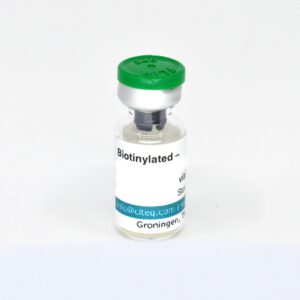
Biotinylated Lepidoglyphus destructor extract
One vial of biotinylated L. destructor extract.

Description
Lepidoglyphus destructor is a species of mite that belongs to the family Glycyphagidae. It is commonly known as the storage mite because it is often found in stored grains, cereals, and dried food products. The mite is small, measuring only 0.5 mm in length, and has a translucent body with a reddish-brown color. L. destructor is a major cause of allergies and asthma in humans, as its fecal pellets and body fragments can become airborne and trigger allergic reactions when inhaled. Infestations of L. destructor can also lead to spoilage and contamination of stored food products.
Biotinylated products have a wide range of applications in the field of respiratory allergy, as many techniques are compatible with them. Due to the high specificity and strength of the biotin-avidin interaction, biotinylation can be used to detect and/or purify proteins. Biotinylated products could be included in various settings of experiments with animal models as the analysis tool to confirm the proper immunization of the subjects or to verify their response to treatment. Additionally, they could help quantify the complex responses from the immune system to make research and diagnosis as precise as possible.
During biotinylation, biotin is attached to macromolecules or proteins. The choice of the functional group to add to biotin is quite large, as a variety of molecules could be attached to it. Besides, it could be used in a different experimental setting with various mediums as the biotin-avidin interaction is not affected by the changes in pH, temperature and other factors. The biotinylated products could also be utilized with standard methods, such as western blot analysis, fluorescence-activated cell sorting (FACS)/ flow cytometry and enzyme-linked immunosorbent assay (ELISA). When a 96 Microwell plate is used, one vial of biotinylated allergens is sufficient to coat two plates.
Additional information
| Size | 1 vial |
|---|




